A Small Boat To The Channel Islands
I like to write about diving. I generally avoid writing about getting
to the diving, dive resorts, dive masters or many of the other things
that go with diving, unless they are part of the adventure. Well, if
you've ever gone small boating in the ocean, especially to the Channel
Islands, you know that often just getting there is an adventure.
This originally started out as a description of some trips I had made
to the Channel Islands in small boats. Then I started to remember how
many trips I had made over the years in small boats. Viewed from over
the years, they all tend to blur together. Some of that blur might be
just that common fog of the 70's and 80's. Still, trips like those
are so memorable and there were so many memorable events on these
trips, that looking close I start to remember that each trip was
distinguished by its own special experiences.
This was one essay that sort of breaks up into three parts. The first is
about boating in general. The second is about my many trips with Kevin.
The third part is about my trips on the Island Breaker with Don.
Conveniently, the older essay about Central Coast Adventures With Dale,
that talks about boating along the Central Coast, can just follow
those.
Seeing these essays after they are written, I see that they could
just as well be called More Ramblings From The Diary Of A Dive Bum.
I guess it is just some parts of the dive adventure that I never really
wrote down before, but this was some of the best exploring that I ever
got to do... Heck, much of the time we had no idea where we were.
Looking at it all together, I find it hard to believe how many trips I
made in a few small boats. They were wonderful adventures.

Anacapa Arch, West End
The Channel Islands are just a magical place for me. A place of exotic
beauty, mystery, surprises, peace and excitement that demand that I
explore just a little bit further, beyond the next point, to the next
island. They are a perfect place to explore. I have spent a lot of time
there, but there is still so much to see and so many
Front Side Coves that I just never
had the time to stop and visit.
One of the best times is when you pull into a calm cove and look down
along the kelp stands until you can see fish swimming among the rocks
and kelp on the bottom. Another is when you are descending far from
a shore and out of the gloom appears a vibrant reef that would
be unsuspected from the surface, but is really a vast lush world to
swim through. Under each cliff are its castoff rocks providing a beautiful
reef. There is far more hidden in the water there, than I will ever
see. I have not yet taken my own boat for a slow explore along the backside
of San Nic or Miguel.
In a big boat you tend to go from place to place. You stop at each dive
site, dive and then wait for everyone to get back abord. You then take
a fairly slow trip to the next spot. On a small boat you pull into
an area and find a place to anchor. Then maybe you go ashore or you
dive. Then, being in a smaller faster boat, you tend to cruise along
near the shore, slowing down whenever there is something interesting
to see. You tend to have less tanks (usually no more than 3 per person)
so you have more time when you are not diving. You also spend less time
travelling, so you have more time to look around. You get to see more and
explore more in a small boat. It's not a cattle boat, but small boats
always mean tight quarters and while the boat is not that crowded, the
crew is certainly loaded full up most all of the time.
Most of the time the Channel Islands present an appearance of arid,
almost desert or chaparral. There are many faces to the islands
though. It seems that the shoreward sides of the islands get more rain
and the backsides get much less. It seems that most of the rain storms
there come from the north and not from the southern ocean.
Sometimes there was green grass on the hillsides of Catalina that
was so thick and lush that climbing up the island presented the hazard
that you could start slipping on that grass and you weren't going to
stop. Go along the backside of Santa Cruz Island from the west end and
the mountain side there looks like a moonscape. If you study the natural
history and the human history of the islands, there is obviously a
great deal to learn and some mysteries that will never be known.
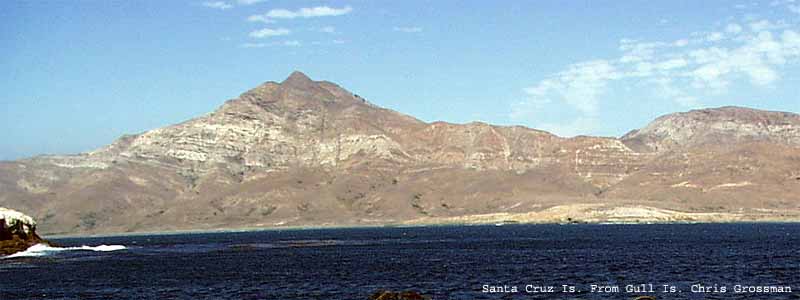
Backside Santa Cruz from Gull Island
The Coast Guard recommends a 40 foot boat for crossing to the
Channel Islands. It is cold open ocean and can get quite rough,
sometimes suddenly and unexpectedly. Still, it's a beautiful trip
that sportsmen have been making in small boats for a long time.
In the early 70's I well remember the small, open wooden outboards
that were common at Anacapa and the southern end of Santa Cruz
Island. These were mostly fishers and looked to be often husband
and wife crews. These were small boats, mostly less than 21 feet and
mostly seen in summer. They were made of coppery red mahogany and were
beautiful. The early 70's constituted the end of the era of these
craft. This was near the beginning of the time of the molded fiberglass
hull. Now a wooden boat like that is a rare classic, but some still do
exist.
Going to the Channel Islands in a small boat is always memorable.
On a good day, it is calm cruising and exploring in beautiful and
empty coves. When things go wrong, it is as harrowing as only a
small boat owner can understand. Just having the boat start and work
good when you get to the ramp is a challenge. Then you also have to
make your own weather judgments and reporting wasn't very good then.
Navigation isn't too tough... unless there is fog... Also, aside from
any diving, fishing or mis-adventures, it is a long tiring ride, when
it's not rough.
Then there is always the pound. It's just part of boating in any small
boat. That is what happens whenever the person driving the boat makes a
mistake. It may be an unavoidable mistake, but it is certainly a mistake.
It is when the boat, for some reason, comes down wrong and instead of
cutting through a wave, it simply
pounds down. It makes the boat shudder in an unforgettable way, because
that shudder goes all the way to your spine. It is the boat's way of
telling you that you made a mistake. Make enough of those and the boat
is going to come apart... and you can clearly and intimately feel that
message. It also feels pretty nasty on your back if you aren't standing
to take the shock.
There is one important caveat to remember about boating to the
Channel Islands. "You can always find calm water at the island".
Most places you go boating out of, you know the conditions as soon as
you leave the harbor. If it's rough, it's going to stay rough and you
might as well turn around. Not so at the islands. No matter how rough
it is when you leave the harbor, you can blindly hold on to some hope
that you can find some calm water when you get to the islands.
This is an extremely important item, because it dictates the nature
of boating there. While diving and boating is easier and generally
more fun when the seas are calm, even if it is rough, you can pretty
much always find some sheltered cove for diving. It's just a matter
of getting there. So sometimes, you go out when it's a bit rough.
Sometimes you go out when it's way too rough. That's what makes for
memorable moments in boating. You look at each other and you both
have the same "did you see that" expression on your faces.
Often the boating aspect is actually more of an adventure than the diving.
It's far more work and there's more to go wrong. Loading a boat starts
with gas, oil and the endless maintenance. Food, clothing and dive gear
come next, if there is no bedding. Tanks are heavy, hard and they
roll really good if not fixed in place carefully. Heck, I've been in the
parking lot with the outdrive pulled apart. Careful on the ramp!
You quickly learn a system where the regulars cooperate in a well
coordinated system that gets the job done amazingly quickly, but it's
still early in the morning and things still tend to go wrong.
The drive to the harbor is the same way. If everything goes good, great
and forget it. If salt water has destroyed a trailer bearing, you're
gonna have an adventure. Brakes. Brakes and heavy loads. Whee... We
slide right through the red light. You've already slid enough and made
enough noise that no one is going to hit you, but I suspect they were
laughing a bit as they watched us slide by.
Both Don and I always had an ear cocked. That may sound like a lobster
slapping in the ice chest, but we knew that sound. That's a water pump
belt that just broke. Time to pay attention. Any boat can start taking
on water for some unexpected reason. Engines just hate that. There are
other sounds you have to listen for, like any new sound. Running out of
gas sucks, because sure as the ocean is wide, you're going to be a long
way from a gas pump
Let me tell you, when you've gotten up early, taken an all day cruise
in the sun, spray and wind, bouncing across swell, dive and then driven
back, you still have to clean out the boat, clean the boat and clean
out the outdrives. We do it for fun.
There are other things you learn about.
If you talk to the guys at the Isthmus or Avalon gas docks at Catalina,
they will tell that at least once a week, somebody comes across to the
island, stops for gas and starts sinking at the dock because they never
put in their plug.
There are obviously a lot of hazards to avoid when in a small boat, but
one is a bit unexpected. Those big container ships are much faster than
they look. Any time you are near one and have to make a judgment about
passing them, be careful. They are very easy to misjudge, especially
if you think that you have the speed to blow by them. You don't. You
can meet them coming into San Pedro Harbor or out in the open channel.
It's not just that they are big, they are boogying. Going into the
breakwater at San Pedro, if one of those ships is in front of you,
don't try to pass them and get in first. You may very well not make it
and you will probably come closer than you want.
Don and Marci were laying down in the back of the Island Breaker. I was
standing with Joe, who was driving. We were in the open channel off of
Ventura. Joe asked whether he should go behind or in front of this one
big ship. I judged he should go in front. (He who hesitates is certainly
lost). We went in front and then turned along side it some to get back
to the desired course. Don could then see the ship sticking up next to
us. I still regularly have to tell him not to bother me, that it was a
valid judgment call.
One thing that is funny about driving a small boat. You usually are
following a course set by the compass. Well, unless you have a long
range view and something to aim at like an island or the shore,
you will tend to deviate from your planned compass course. This is
called 'falling off'. You fall off your planned course. Almost all
people do this. Then you have to look at your compass and correct
again. What is interesting is that the amount and direction that a
person falls off is generally consistent. They always fall off to the
right or left, but not both. Some people fall off a lot, some fall off
less, but it is usually the same amount... Kevin rarely fell off much,
but he was the exception... Me.. 15 degrees left. Considering that the
difference between hitting the east end of Anacapa and passing to the
west of San Miguel Island (50 miles away) is only 15 degrees from the
mainland, that can be important. You can learn your natural fall off,
but it is still hard to adjust for correctly.
There are eight Channel Islands. Most people have heard of Catalina, if
not the rest. On the east end of Catalina is the town of Avalon. Many
people know of it and it is a respectable town with mansions, businesses,
dive shops, tours, underwater parks, all the amenities of a resort and
the Casino. Also, zoo crowds in
summer. Less known is Isthmus towards the west end of Catalina. On both
sides of the island are deep coves. The seaward side cove is called Twin
Harbors and the shoreward side is called Isthmus. As opposed to Avalon,
it is like a sleepy, dusty village with dirt roads and palm trees. There
is a gas dock there and sort of a dive shop (you can get fills if someone
is there). There is even a store, restraunt and a bar that is now open
all year, instead of just in summer. For boaters and divers, Isthmus is
quieter and provides all that is needed. There is real good diving right
close to Isthmus, including Eagles Reef, Bird Rock, Ship Rock, Isthmus
High Spot, Blue Caverns and other excellent sites. Often Isthmus was our
destination. Both Isthmus and Avalon are crowded from Memorial Day
to Labor Day and are insane during the annual Pirate days, but both are
peaceful other times, though the weather is usually excellent all year.
Isthmus, especially, outside of tourist season, is a quiet pleasant
place. The kind of place for a quiet pleasant cruise.
Cruising the Channel Islands With Kevin
It seems I've known Kevin forever, but I guess it's really only
since High School when we first met and tried to mess with each
other in shop. It didn't work well for either one and we ended
up as friends so that we could seriously mess with each
other.
It seems like almost every weekend, I was water-skiing
with Kevin, Richard and Arthur. It was Arthur that had the boat
and we'd all head up to Piru, Castaic or Pyamid Lake. For longer
trips we ended up at the river, Pine Flats Lake or Mission Bay.
Often my brother was along with his flat bottom. That was one
shockingly fast boat. In the early morning the lakes were glass
and great for water-skiing. Mid day, the water would get rougher
and skiing would slow for a bit. I even got a bit of a tan one
summer doing this. It only took about 2 years to heal. Anyway,
water would calm some in the afternoon and we'd be skiing again.
Then in the evening, I'd make the last trip across the lake
behind my brother's boat back to the dock, flat out.
If you wonder why I write about water-skiing here, it definitely
is part of the context. It was just part of what we were doing
at the same time as we were diving. Diving just lasted longer.
To me, it's also a statement of amazement about how much time
we had in those days. At least we used it for fun.
Life wasn't all water-skiing though. There were plenty of free time
for diving. I was constantly shore diving and I had been making trips
to the Channel Islands on Charter boats like the Sea Bee and Sea
Packer, almost weekly for a couple of years, but this was very
different. Kevin's father, Glen, had been taking small boats to the
Channel Islands for many years. Instead of slowly chugging over in
a 55 foot, heavy, wood hulled boat, this was flying in a 21 foot
fiberglass rocket that glided over the water as we went
to Anacapa.
We pulled into this fairly protected cove that they knew of on the
frontside and went onto the island. It was legal then. It was only about
a 150 foot walk to the other side of the island where the ocean waves hit
the small beach. I walked along the the shore of Anacapa Island for the
first time. It was enchanting. In spring and early summer the islands get
verdant green and there are yellow wild flowers everywhere. As I describe
elsewhere, scuba and freediving in the calm frontside coves is great with
good vis and lots to see, especially then. This was when the bottom was
thick with huge red urchins and warty sea cucumbers. Scallops were common
in the cracks behind the urchins and there were even legal pink abalone
part way buried in the sand at the bottom of the rocks at the mouth
of the coves. There were still some big sheepsheads even at Anacapa and
the Calico bass were thick. In those days, the large purple jellyfish
were common and you could count the blue sharks you passed by their fins
sticking up. There were a lot of them.
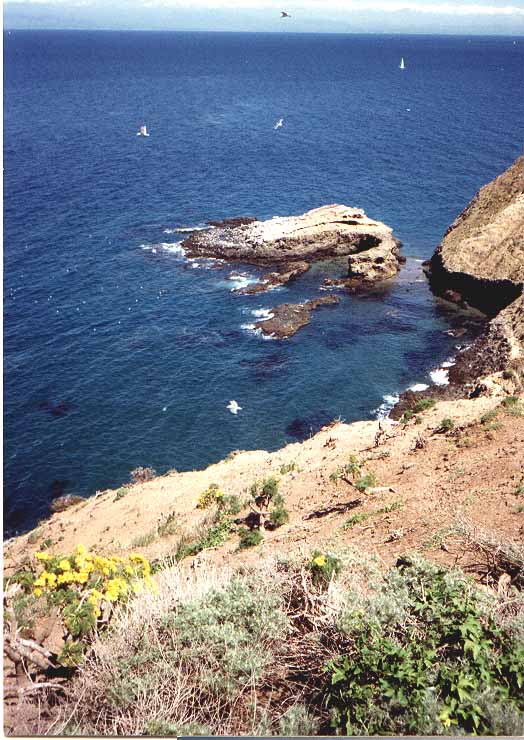
View From Anacapa
For Glen, cruising was just what he did for fun when he wasn't doing
business. He was a bit of an adventurer and he had a lot of good
stories from over the years. He was a diver when that meant just a
mask and fins.
On these trips, I would burn my tanks with Kevin or Bill and then free
dive along the island shore for hours at a time. Sometimes we hiked
onto the top of the island itself. Glen would be rowing around in his
small inflatable or just relaxing on the island.
I made a lot of trips over many years, to Anacapa, Santa Cruz and
Catalina with Glen, Kevin and Bill. It was always fun.
Then Kevin got Pinky.
He finally had his own boat. It was this
17 foot, pink, high sided fiberglass bathtub with a 75 hp Evinrude
outboard. It was made in 1956. That made it older than him.
We were stoked. A couple of kids at Channel Islands Harbor with a boat,
ready for our first trip to Anacapa. We got loaded up and headed out of
the harbor with about 7 other boats... all but 3 of which turned
back as soon as they got in the swell beyond the breakwater. It
wasn't a huge day, but it was big. A bit of discussion and we
figured we had to try it. It was the first time out. So on we
went due south, which should take us to the east end of Anacapa.
Kevin was standing on a plastic step stool for driving, so that he
could see over the windscreen. After a few miles of bouncing along and
a few launches, the only boat still following was a nice new cruiser that
was over 30 feet and they weren't passing us. The entire boat flexed as
it went through the waves. We were really bouncing along when
there was this huge crash of shattering plastic. Kevin's step stool
was plastic fragments, but that was not our first thought. We
both thought it was the boat cracking up at first.
Well, it was a beautiful day when we got there and calmer when
we went home.
There was one thing that really made small or large boating to the
Channel Islands a lot nicer than it might have been. Going back to
dock, you were always going with the waves. Never into them. A lot
of times, even with a big boat, you can get on a swell and surf for
quite a ways. So if you could make it out, you could always make it
back... Unless it was Santana Wind conditions and then you might well
want that 40 foot boat the Coast Guard mentioned. Usually though, the
trip back was a relaxed beautiful ride.
Of course, there was one other thing about Pinky. It was an old boat
with an old design. The bottom behind the V of the bow, was sort of a
flat curve. They made boats that way for a while... Then they learned
that that design can cause them to flip if you surf a swell...
Note that the Santana Winds (sometimes mis-called the Santa Anna's)
are always blowing from shore, but they usually come from the deserts
high up above the land and drop down to the ocean 60 miles out. If the
weather is right though, they drop down through the mountain passes
and blow along the water. They may or may not be a problem, but
they can be a bad one, especially at Catalina. A boater must
keep a weather eye open for them and smell the air. If you smell sage,
the Santanas will be there soon and it is wise to look for shelter.
You can get stuck for a day or two in the lee of the island depending on
where you are and how bad the winds are.
The Santanas can make the ocean flat for shore diving though.
Then another thing to watch for then is if the water
temperature suddenly drops about 4 degrees. It means that the winds
have blown off the top warmer water and pulled up cold upwelling
waters. Vis along the shore can get extraordinary at that time.
Anyway, we made a lot of trips to Anacapa and a few to Santa Cruz Island
in Pinky. It's great trying to figure out where a good dive spot might
be. These were spring and summer trips. The air was warm. We would just
dive in coves or look for kelp offshore. We had no electronics beyond a
compass and a flashlight... There was only one thing that was
uncomfortable. Kevin always liked to leave the island later than I
would have. We were often one of the last boats to the harbor, just a
bit before dusk. Well, there was this one time when the boat started
and we got a few miles from the island. Then something happened and
suddenly the engine would barely run. We tried everything we knew, but
it would just sorta rough idle along as we barely moved. It was late
and though I saw two boats, they were a long way off. That flashlight
I mentioned... Well, there was one other boat a couple of miles away
that was not going in the opposite direction. I quickly recalled
how to SOS and we shut down the engine so that we weren't moving.
The folks on the other boat didn't really want to tow us, but
it was like a 50 foot swordfish boat, so they did.
The post mortem showed that we had a broken distributor shaft.
How we ever got the motor started was a mystery.
We had a lot of fun with Pinky. We were kids having a great time
exploring and everything was brand new.
I went up north for a couple of years after that and I have no idea
what exactly happened to Pinky. It was time for replacement before Kevin
ever got that boat. Kevin went through a succession of boats. He was a
bit of a wheeler dealer, so he would buy a boat and maybe sell it a short
time later, usually for more than he bought it for. He kept most boats
for only a couple of years and never for more than 3.
His brother Bill had a boat too now. Sometimes we would go out alone or
with his brother or father. Actually, his brother Mike had a boat too, but
we don't mention him. Since they were more into cruising, we would only
bring a couple of tanks, but I liked free diving so much that tanks
didn't matter that much to me. This is when I got in the habit of swimming
out over the sand past the cove rocks with my tanks. You don't always find
much, but anything you find is almost guaranteed to be interesting and unusual.
Any small isolated rock in the sand will be used as cover by every animal
that can glom onto it.
Also, in winter, I would see some lobster boeys a ways offshore and just
jump in there to see if they were sitting on a reef. You have to be a bit
careful of your depth doing that, but I found some amazing shelves that
seemed rarely visited by divers because some had large abalone or scallops
on them. It seemed like sometimes the lobsters had already found the traps
and sometimes they hadn't. I remember more than once finding nice
lobsters in ledges right near traps. There seems to be a lot of small reefs
between say 100 feet and 115 feet, off of Santa Cruz Island. Finding them is
another story. There are big Calico bass down there.
This was also when I could free dive comfortably to 70 feet. Past about
50 feet, the fish don't know what you are if you aren't blowing bubbles.
I usually didn't do much spearing when on a small boat, but I still liked
playing hide and seek with the big calicos. They don't like being snuck up
on.
Sometimes, when cruising out, we would just stop mid channel and fish,
but that usually just meant catching mackerel or barracuda and then
having a shark grab that. If you got them in, the objective was to get
the hook out without them ever coming onto the boat.
Sometimes we went to Catalina. Avalon is a fun town for pizza and watering
holes. Sometimes we would stay over night anchored outside the harbor there
instead of at the Isthmus. There is great diving all around Avalon.
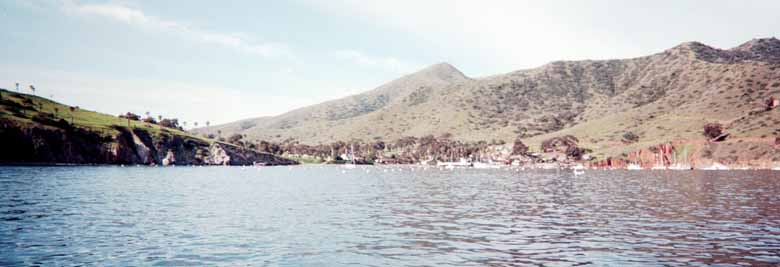
Isthmus
I should mention one other boat. Kevin loved to go to the LA boat show.
One time when I went with him, I was wandering around by myself when I saw
the Mercury exhibit. This was the first year (or near to it) that Mercury
was selling the Black Max line of outboard motors. I looked at it and
told the sales women 'wait until my friend sees that'! She said that he
already had and that he hugged it... That was Kevin's way of judging it's
size.
So Kevin ended up with a 125 HP Black Max mounted on a 16 foot ski/race
boat with maybe 4 inches of freeboard. Great ski boat. Interesting ocean
boat. We took it to Catalina a number of times. The trick is to never
stop mid channel unless it is really calm. We did do a fair amount of
ocean skiing, but really it was still a matter of going to coves and
Catalina with other boats... Just with that boat, we had to do a lot
of waiting for others to catch up.
If you know ocean boating, you know it was just a matter of time.
We had already made a couple of trips back from Catalina in the afternoon,
when the seas had started to pick up. You have to drive a boat with a
fairly nimble touch, but no one did it better than Kevin. This one
afternoon though, it was really big even if it was trailing seas.
I was sitting backwards in one of those padded contoured seats that
they put in ski boats. My view was of whitecapped walls of water trying
to fall on the boat from behind. We got launched every couple of minutes.
At least that boat was a good flyer. Three
times we launched good enough to knock the wind out of me. Kevin sorta
apologized, but he was busy. In conditions like that, you just have to
rely on your boat and driver...
After that trip, there were lateral crack lines in the boat, so Kevin
sold it. Actually, I think I liked the bigger boats for the ocean.
Talk about rough rides. He got one boat that had a V8 engine, but the
boat was really designed for a V6. The extra weight in the back made
it bounce a lot. Mara almost lost her... chests on that first trip. Then
Kevin got those fins that bolt onto the bottom of the outdrive to lift
the engine for stability. It rode like a Cadillac after that.
After his divorce, the Wendy Sue becamse the Wendy Who.
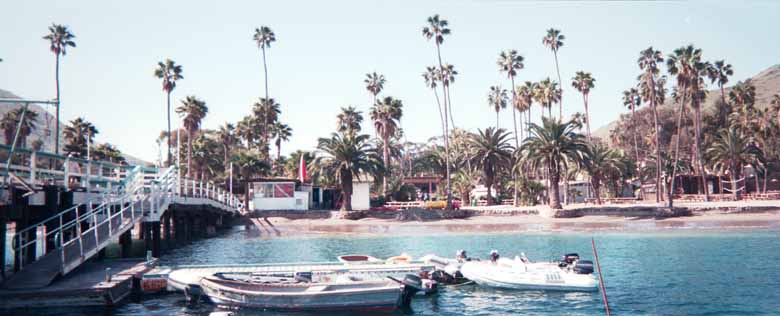
Quiet morning at Isthmus
The Island Breaker
Really, for me, this was the time of the Peace and the Truth, taking
Wednesday trips to San Nicolas (The Badlands) and Santa Rosa (Talcott Shoal)
Islands. Then if I wasn't set for skiing or bodysurfing, I would go on a
small boat to the inner islands on the weekends.
This was the great lobster hunting times, say the mid 80's.
Then I met Don and Glen. They owned the Island Breaker.
Originally, it was Glen's boat, but as I hear it, Don was driving along
and saw an 8 foot shark hanging in a tree. He figured he had to check it
out and that is how he met Glen and bought into the boat. I won't say that
either one of these guys was extremely sane (or myself for that matter),
but they did like to dive and the Island Breaker was a real dive boat.
It was a 25 foot boat with twin 6 cylinder Chevy engines with Mercury
outdrives. That gave it good speed and reasonable gas consumption. It
was ugly, but it did the job. We could carry 5 divers comfortably enough
and 14 tanks. There was a big swim step at the back just made for diving.
The deck had burned off years back and was replaced with a simple deck that
made it look like a big ski boat. It had as much capability as you had nerve
to try. With the barrel under the deck, it carried 85 gallons of gas. They
had taken it to San Miguel Island on calm days. Best of all, it was very
fast.
I hear tell that they came straight back from San Miguel Island, all the
way to Ventura Harbor one day and got pulled into the Coast Guard docks
for inspection. They were basically told that the only ones that drove
that route that straight and fast, were drug runners.
Well, then Glen pulled that slick maneuver that got him in the pokey, I
was making good money doing side jobs and I must have been a bit insane,
cuz I bought Glen's interest in the boat. We all know about that day
for a boat owner.
I had been making trips with them for some time, so that didn't change
anything much. If you're going to partner in a boat, a mechanic like
Don is a good person to do it with. What a lot of work!
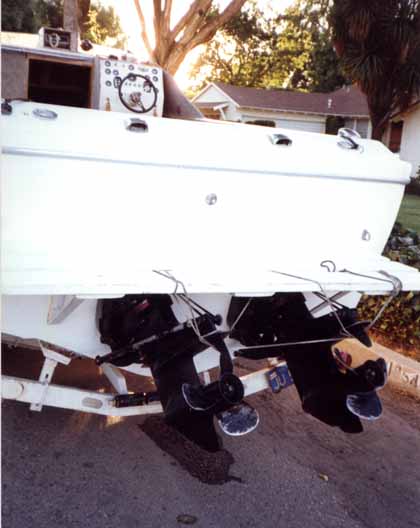
The Island Breaker
The good part was that it was a fast trip to Santa Cruz Island. We'd load
up and be there in a bit over an hour from Ventura. If there was a
swell from the north or west, we would go straight to the back side of
Anacapa and turn up to Santa Cruz Island, flying over the calm water.
If the swell was from the south, we would stay in front in the smooth
water there. Sometimes it was just rough everywhere, but that was why
it was called the Island Breaker (one reason anyway). It was heavy and
had a nice V so we could go into rough water.
Then if it was a nice day we would go up the backside of Santa Cruz
Island. Realize, that is a 27 mile long island. There is a lot of diving.
Pick a cove, any cove, or just some offshore kelp patch. We looked for spots
that looked to be too small for the charter boats to want to visit. We
would stop at Gull Island or go on to Santa Rosa. If not Santa Rosa, we
would stop at Kinton Point where there were still plentiful abalone and
fish. The diving inside of Frazier Point (the north west corner of Santa
Cruz Island) was good. The diving outside (like the Potato Patch) was better,
but a challenge if there was any swell. Then a dive under the northern cliffs
before heading home. In between, munch Fig Newtons and eat mystery chicken.
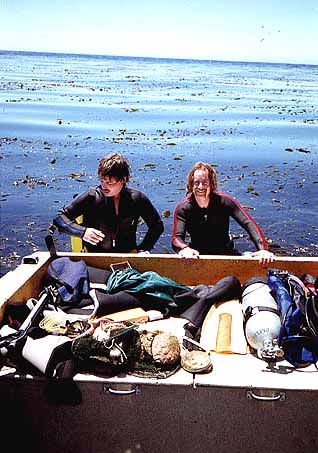 |
Glen and Don at Kinton Point.
Notice the Pink and Red Abalone.
|
It's truly a different world out there from nearby LA.. There may be
other boats out there, but not many past the south east end of Santa
Cruz.
Along the backside are a number of deep coves that go back to sandy
beaches with streams that come down from the island canyons. There
are often power and sail boats anchored in the well protected back of
these. From what I saw, I can only imagine that they anchor there all
summer, perhaps longer and occasionally go to shore for supplies. Heck,
if they are really serious yaghties, I would expect that they mosey on
down to Cabo or Acapulco for summer.
These coves are very deep and you may never get really see into
them from charter boats.
Sometimes, hunters with bows go up the canyons beyond the beaches looking
for wild boar.
Sometimes if we wanted to go to Santa Rosa Island, we would start from
Santa Barbara Harbor and make the long Channel Crossing there, but then
we could dive the backside near Bee Rock. That is some great diving.
During lobster season, we usually just went across to the frontside to
Santa Cruz where it tended to be calmer and we could do frontside diving
for lobster. I always liked tooling around China Point looking for bugs
and scallops. We used to find 3 or 4 pounders fairly often, bigger
occasionally. Every point
on the front side is rich with life. Every cove was a good dive.
We took the boat into Painted Cave and were real lucky not to
lose a prop. You could see the rocks just below it. Next time, we just
swam in, but went in a ways further than a boat can go. Sea lions are
barking and bouncing around everywhere. They don't seem to like their
privacy and feeling of safety disturbed there.
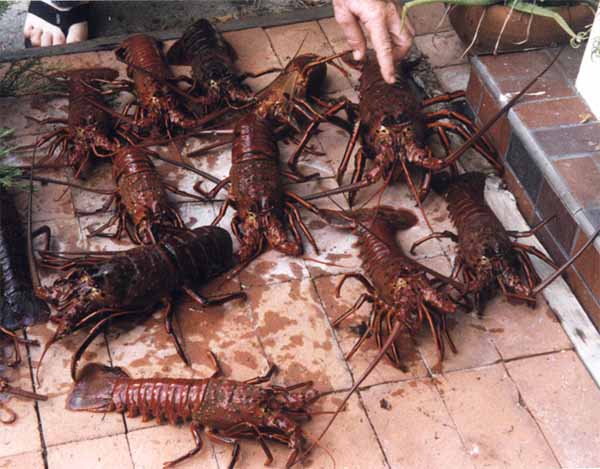
After A Day Backside Santa Cruz
Don, Pat, Alan and myself went to San Nicolas Island for a season opener.
We got to do some great lobster diving
Bouncing For Bugs in the shallow water
and tide pools near shore.
Shortly after that trip, we loaded up Don, Pat, Glen, Alan, Myself, 14
tanks, 85 gallons of gas and off we went to San Nicolas Island. The Island
Breaker hadn't been there. Heck, we didn't even have a course. There was
swell, but it had about a 13 second period from the west. The slow period and
the fact that we were going due south made it an OK ride. When we got about
10 miles behind Anacapa, I was able to guesstimate where Nic should be, from
all my trips there on the Peace. I saw it.
It was hard to believe that the boat could plane with all that weight, but
we made it there in about 2 1/4 hours. Since the island is Navy owned,
we were radioing ahead as you are supposed to do, to ask about closures.
Well, they waited until we were about a mile from the middle of the north
side of the island and then sent a helicopter to chase us away. Then we
were heading west directly into that big swell, but we weighed so much that
the Island Breaker just broke on through it. I suspect that they were
surprised at the speed we could make into it. I had really wanted to dive
the frontside tide pools. What a hassle, but it almost looked like a jet
up there was hovering.
Anyway we got to the west end and did our diving. Got some bugs and got
home... with almost no gas left.
For those of you that don't know it, San Nicolas is a long, challenging
trip to make in a small boat. It was probably about 60 miles to get
back. The diving is great, but a charter boat is an easier way to go.
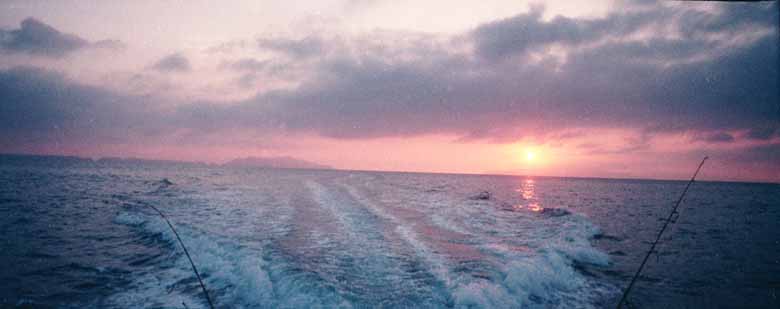
Going Home
You perhaps ask why no more electronics. Well, we were out one day when
there was some fog, but it wasn't too bad... until we got off the east
end of Santa Cruz Island. We were heading for Yellow Banks and suddenly
everything vanished to gray. Hmmm... Then a boat went by that had radar.
We got behind it and went on. By the time we came out of the fog, there
were 5 boats lined up behind us.
I did the sensible thing and bought a Loran C. We mounted it up and it
worked great the first trip. It was weird. Our dead reckoning that we
were used to using, said 'over there'. The Loran said 'no, here'. It
was 'here'... Dead on. I liked that.
Well, Lorans need a really good ground and so there was this braided
ground wire that trailed from the unit. I really didn't know what to do
with it, so it sort of just sat out, unconnected. Did I mention the
electrical on the boat? Well, it wasn't perfect. Heck, if you had wet
feet and a bit of luck, you could get a nasty shock off that one starter
key... Well, the Loran ground wire found it's way to that hot key... It
smoked the Loran. I sent it to be fixed, but it was never the same again.
Since I'm just rambling, I guess I have add a bit about Glen. He made more
mistakes than I am prone to, so his story ended up being more interesting,
if you know what I mean. Glen was a real good guy, but.. well, he did
Glenbys and Glenbys are bad mistakes.
Anyway, he got out of the pokey after two years. How he got in was quite
incredible and involved getting clocked by the CHP while airborne and
that wasn't his worst transgression that night...
Glen got another boat. This 21 foot ugly green thing with a single
outdrive.
The story I heard was that his father went to the ramp at 10 pm and his
truck was still there, so he called the Coast Guard. 4 am the CG helicopter
spots them drifting. By then they are wrapping themselves in aluminum foil
to try to keep warm. Seriously, these guys would go out with no more than
a T shirt.
Well, this guy is no dummy. That's not gonna to happen again. So he got
a kicker engine big enough to get him back to dock and mounted it to his
swim step... But you have to also chain them... That fell off mid-channel
sometime...
Then there was the time we towed him back. Everyone came onto our boat
for the tow.
One of his drunk buddies chose me on during the tow,
cuz I didn't like him tailing a bug I got (it's illegal to possess then).
When we got to dock, I clarified things for him.
Believe it or not, there were other stories about Glen as well, but
he did get to do some good diving.
Last I heard, Glen came into some money and got another real nice boat.
Well, I hope you found this a bit amusing. Small boating in the big ocean
is always... interesting. There are other essays on the site, about fun
on small boats at other times and places. There was the stories about the
the trips to Margarita Ville and boating from Point Sal to South Big Sur in
Central Coast Adventures With Dale. That was
some great diving and some wild boating.
I haven't put much in about my inflatable trips down here in San Diego.
There is some great diving off of La Jolla and Point Loma. Inflatables
bounce too much though.
Now a days I prefer going with Lem in his 28 foot BayLiner. Radar,
differential GPS, hot showers, compressor, bunks, shelter and it's fast.
That has been good for some great diving. I've written some essays about
those trips. We do some good night diving... then it's a stealth mission..
... I can't wait to go out to local reefs out of Oceanside this year with
John in his boat..., but that will be another story.
Enjoy the diving, seahunt
Back To Home Page
Addendum
I donno exactly how to put it, but I think that it is fair
to say that taking a small boat to the Channel Islands takes a
certain kind of fortitude. Partly it is an individuals urge to
travel and explore places in the sea that few others have a desire
to visit. Those who take small boats across the Channel are
explorers, but they must be more than that. Boaters that visit the
Channel Islands reqularly learn to dress warm, but it takes more
than that, because the cold of the ocean is limitless and so
ultimately, the only thing that will resist that cold is the
endurence of the individual who just considers it to be a cost of
the visit. That is the way of the sea, a person coping with the
impersonal.
Sometimes when boating, you have to put up with seasickness. It
makes you miserable and weak, but the ocean doesn't care so the
individual must ignore it and just carry on.
Sometimes it is just rough and you're going to get beat and it's
going to go on for hours. Each wave becomes a challenge to carefully
climb and then not crash down into the next one. It requires confidence
in both the crew and the skipper.
What requires fortitude more than anything else though is the age
old issue of mariners going out to a place that can be as hostile
and dangerous as it is vast and beautiful. You just have to have
a nature that can feel at home in such a wild place without being
overwhelmed by it or to give in to fear when things get scary.
I've known a number of people that are this way. You know, salt water
in their veins, these are people I call my friends including Glen,
Bill, Kevin Bray, Richard, Don, Marci , Pat, Allen, Glen,
Dale, Mel, Dan and a few others. We had some great trips.








